The AfD in Saxony and Thuringia has firmly established itself as a "workers' party", according to an analysis by researchers at the Technical University of Dresden (TU). In the state elections, its share of the vote among employees was particularly high at 45 percent in Saxony and 49 percent in Thuringia, according to a report by the Mercator Forum Migration and Democracy at the TU.
CDU and the Sahra Wagenknecht Alliance (BSW) were very often voted for by older age groups (60 plus) in the two Free States. The AfD achieved significantly worse results in this age cohort than in the middle and younger age groups.
Left parties lose votes among older voters, Greens among younger voters
In both states, the Left party has suffered heavy losses of votes, particularly among those aged 60 and over, according to the report: "In these voter groups, a particularly large proportion of their former voters have obviously turned their backs on the party.". The Greens, on the other hand, mainly lost votes in the 18 to 24 age group - more than half compared to the 2019 state election. For Saxony, the analysis also found that the more rural and therefore less densely populated a municipality is and the further away the municipality is from the state's population centers, the stronger the AfD's election results are.
These issues played a role
In Saxony and Thuringia, immigration, internal security and crime as well as social security were the issues that played the biggest role in people's voting decisions, according to another finding. In both federal states, the AfD was said to have the highest problem-solving competence when it came to immigration and internal security.
According to the preliminary results, the CDU achieved 31.9 percent in the Saxony election, with the AfD close behind with 30.6 percent. The BSW achieved 11.8 percent from a standing start. The SPD landed at 7.3 percent and the Greens at 5.1 percent. The Left Party slipped to 4.5%, but can still enter the state parliament thanks to two direct mandates won in Leipzig. The FDP sank into insignificance with 0.9 percent.
In Thuringia, the AfD became the strongest party with 32.8 percent and a clear lead over the CDU (23.6 percent). The BSW achieved 15.8 percent at the first attempt. It was followed by the Left Party (13.1%), which fell dramatically compared to the 2019 state election (31.0%). There were also losses for the parties of the Berlin traffic light government: the SPD is only just above the five percent threshold with 6.1 percent. The Greens (3.2 percent) and the FDP (1.1 percent) are no longer represented in parliament.
Copyright 2024, dpa (www.dpa.de). All rights reserved










